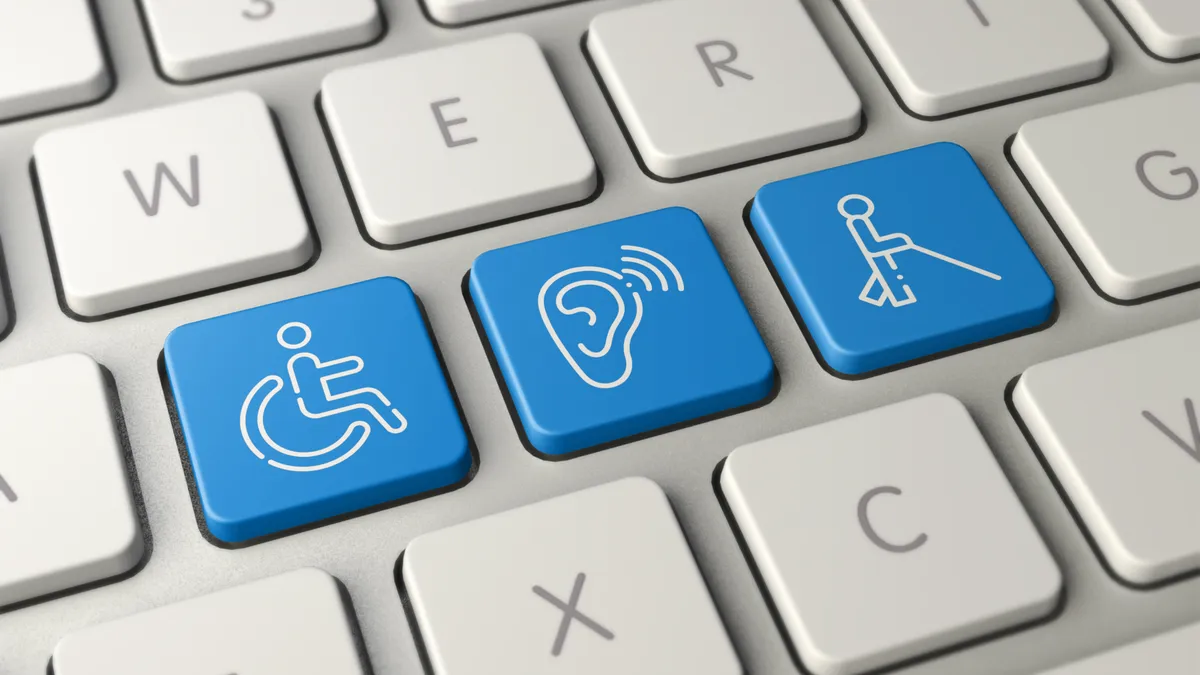As HR professionals dig into the accessibility aspect of DEI, potholes abound. “Accessibility is one of those terms that engenders a lot of anxiety for folks,” Kelly Hermann told HR Dive. “They’re like, ‘I don't want to do it wrong. I don't want to be seen as the person who is going to kick the person in the wheelchair or, you know, be discriminatory,’” she recalled.
As VP of access, diversity and inclusion for the University of Phoenix, Hermann addresses campus accessibility concerns. She shows up for students with disabilities, as well as faculty and staff. As Hermann and her department educates community members on how to show up for their colleagues and course-takers, they seek to assuage worry with one key reminder: Accessibility is a journey.
“You're not going to get to a certain place and say, ‘That's it. Everything's accessible. I don't have to worry about this anymore.’ There's always going to be some work to do,” Hermann said. “You're going to learn some things, you're going to hit some potholes, and that's something that we have to expect along the way.”
Often, employers jump to the obstacles that exist in physical spaces: nonexistent ramps for wheelchairs, manual doors that lack motion sensors, and the like. But the digital world presents challenges as well. Hermann and the U Phoenix accessibility team likes to “demystify” disability for campus members seeking their counsel, she said.
Accessibility is an exercise in thoughtfulness
For example, Hermann said, “PDF documents are notoriously inaccessible, because they're not structured correctly.” A person using assistive technology may still be unable to access the content, she continued. Similarly, when sharing links, understand that a screen reader can only do so much to guide a worker to the right URL, she said.
“Are you making those links descriptive and are you using keywords? Or are you just saying ‘click here’ and that's your link?” Hermann asked. Like a sighted person, an individual with a disability can also scan a webpage for links with assistive technology, but this happens audibly, Hermann said, “They tell that tool to skip by link and this is what they hear: ‘Click here.’ ‘Click here.’ ‘Click here.’ ‘Click here.’ With four links on the page all hyperlinked with ‘click here,’ [they] don't know where [they’re] going.”
Hermann is a big advocate of weaving accessibility into every aspect of the workflow. Over the course of her conversation with HR Dive, an ethos emerged: sure, technically, employers are well within their right to wait for a worker to request reasonable accommodation under the ADA, but why not be accommodating from the start?
Workplace disability rights advocacy extends back decades
Hermann said academia hasn't always been so progressive, but there's always been that aspiration. She spoke of how higher education was a pivotal battleground for disability rights since the 70s, nodding to UC Berkeley sit-ins in favor of Section 504 of the Rehabilitation Act of 1973, which had been vetoed by President Nixon.
Building on the foundation of Ed Roberts and his quadriplegic gang The Rolling Quads, Judy Heumann and Kitty Cone led a sit-in of more than 100 students at the San Francisco Department of Health, Education and Welfare offices in 1977. Five years prior, protesters with disabilities rallied against President Richard Nixon’s veto of the Rehabilitation Act of 1973. Section 504 of the act — which aimed to make public buildings accessible and to bar federally funded programs from discriminating against “otherwise qualified handicapped” job candidates — initially remained unsigned.
After the 504 sit-ins, Joseph Califano, U.S. Secretary of Health, Education and Welfare, remedied this in April 1977. “A lot of times, college students and the youth were the ones like, ‘You know what? I'm done,’” Hermann said to HR Dive. “They took so many lessons from the Civil Rights Movement.” (In this case, quite literally: the Black Panther Party cooked and delivered meals to the 504 sit-in protestors that government officials sought to starve and flush out.)
Heumann is an advocate for independent living, an approach that returns decision-making power — from finances, to employment, to general existence in the world — to folks with disabilities. Notably, UC Berkeley housed what’s generally recognized as the first Center of Independent Living, established in 1972. Along with facilitating independent living through inclusive workplaces, employers striving for diversity, equity and inclusion can also consider alternative models of disability.
A new way of thinking
The problem, from Hermann’s perspective, is that American institutions, including employers, take cues from “the medical model” of disability. With the former, people hear that a colleague or peer has a disability and “immediately think something's wrong with that person,” she said. “When you approach it from the standpoint of ‘that person has something wrong with them,’ you have to fix it. When you do put the emphasis on ‘fixing it,’ it’s usually on the body and on the person — and not so much on the environment.”
The “medical model” of disability is foiled by “the social model,” which has its roots in U.K. disability rights activism. The social model underscores the idea that disability identity is the result of inaccessible spaces.
“You might have somebody who can't use their legs and they have to use a wheelchair to get from point A to point B, [but] the disability isn't so much about the fact that they have to use a wheelchair. It's that they can't get into your building because there's a step, and the wheelchair can't navigate that,” Hermann said. The environment is inaccessible to a person in a wheelchair because there's no ramp to get them to the door.
Her industry has been mired in the medical model; in practice, she said, it looks like faculty telling her, “Don't worry, Kelly. When I have a student who needs an accommodation, they can tell me and I'll make sure it happens.” Her response is to champion accessibility and inclusion from the beginning. If a faculty member is designing an online course with video content, Hermann will say, “Why don't we caption it from the get-go? Because then you don't have to do anything extra, it's already going to be done.” Not only can it benefit the whole class, but the student with a disability doesn’t have to expend extra time and energy asking for an accommodation.
In an example of a blind employee needing to use an HR management system that doesn’t have proper alternative text for a screen reader, Hermann said even if that employee’s manager provides them the accommodation of a human aid, that process can still be cumbersome for the worker. Additionally, the employer has to find a reader who is available and they’re stuck on that reader’s timetable.
With dignity, employ folks with disabilities
“If you can't make the actual thing accessible,” Hermann said, finding a human assistant is the next best accommodation. But that still is putting a heavy, heavy burden on the employee with a disability, because they can't be independent. The employee’s workflow may no longer be optimal. “They had to ask for help. They had to out themselves again, and remind folks that they had a disability.”
Asking for help from non-disabled peers can be harrowing as a disabled employee, as there may be greater insecurity about feeling incompetent. “For a lot of our colleagues with disabilities, that's a voice that sometimes gets really, really loud because of the situations [authority figures] put them into.” Even when employees are supervised by the kindest managers, Hermann said, “that person is still going to feel a little defeated.”
Along with being proactive about accommodations, employers can limit discouraging and harmful situations for workers with disabilities by adopting an open door policy. “The other piece of it is being open to questions,” Hermann said. Specifically, she outlined, “The disability community is so heterogeneous, in terms of everyone having different [disability] intersections with other parts of their identity.”
For example, Hermann said has type two diabetes and a friend of hers has muscular dystrophy and uses a wheelchair. “We might have similar backgrounds in that we're both white women, and we both went to the same small, private liberal arts college in upstate New York.” But their lived experiences differ.
Even folks who work in DEI should continue self-educating, she said. “Always be looking to learn, especially as advocates and allies. Understand we can talk from our own lived experiences, but that's not the totality of the disability experience.”






















